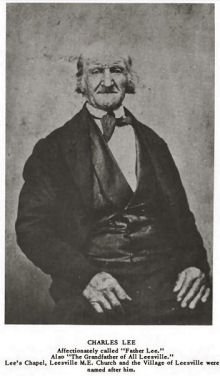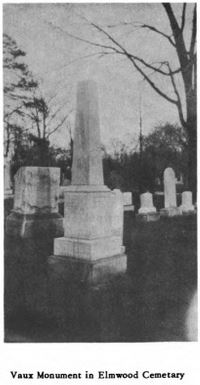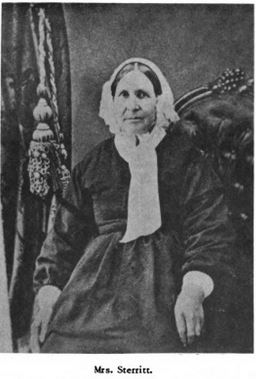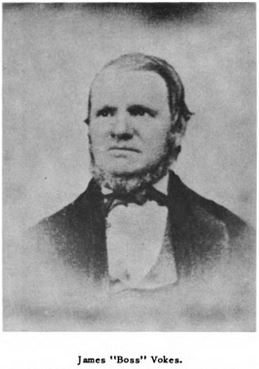An English Community
Chapter 1
James Vaux and Charles Lee
 James Vaux was born in England in 1759. Charles Lee was born in Yorkshire, England, Feb. 15, 1788. Little more is known of these two men although they were among the most important of the settlers who developed Fort Gratiot Road. They are thought to be the first English settlers of the region, but the only information the records give us is that Charles Lee's oldest child, Thomas, was born in England March 12, 1810 and his daughter Elizabeth married Robert E.Walker in 1837, both natives of Yorkshire, England, and settled in Wayne county. Robert was handy man and secretary to Daniel Webster, and since the Lees came directly to Fort Gratiot Military Trail it is probable they were married in the Lee home. They built a very comfortable brick house on the south side of the Trail near the present corner of Gratiot and Belvidere. James Vaux was born in England in 1759. Charles Lee was born in Yorkshire, England, Feb. 15, 1788. Little more is known of these two men although they were among the most important of the settlers who developed Fort Gratiot Road. They are thought to be the first English settlers of the region, but the only information the records give us is that Charles Lee's oldest child, Thomas, was born in England March 12, 1810 and his daughter Elizabeth married Robert E.Walker in 1837, both natives of Yorkshire, England, and settled in Wayne county. Robert was handy man and secretary to Daniel Webster, and since the Lees came directly to Fort Gratiot Military Trail it is probable they were married in the Lee home. They built a very comfortable brick house on the south side of the Trail near the present corner of Gratiot and Belvidere.
The earliest English settlers of which we have record were Charles Ackley, who came in 1832 and his brother, William Ackley, who came in 1833. Then the Sterritt family came in 1837. Sterritt Ave., which marks the north boundary of their farm, is named after them. This was the beginning of our English community.
Charles Lee kept a diary and some of his descendents recall seeing it and reading parts of it, but all efforts to find it by the historians of Bethany Methodist Church and the Episcopal Church of Our Savior and those who have helped us have been unsuccessful. (The historian of the Church of Our Savior is a great-granddaughter of James Vaux.)
James Vaux was a descendant of one of the French Hugenot families that emigrated to England during the religious persecutions that lasted more than three centuries. The name was originally De Vaux. The "De" was dropped when they were settled in England, and the younger generations Anglicized it to "Vokes." He wore the old style British knee breeches as long as he lived, which was a source of amusement to the youngsters. He died May 16, 1844. A text on his monument in Elmwood Cemetary, which was probably the text for his funeral sermon, reads: "Mark the perfect man and behold the upright, for the end of that man is peace." Burial was originally at Seven Mile Road and Fort Gratiot Road.
Charles and Betty Lee lived on in the brick house, two great souls tenderly loved by the entire community. Charles was affectionately known as "Father Lee," some of those closest to him calling him "Daddy," or "Grand- father," for he was always known as the father of the settlement that was named after him, —Leesville. These were quiet folk, serving the Master and their community in any way the opportunity to serve was open.
Her memorial, engraved on the James Vaux monument in Elmwood Cemetary reads: "Betty, Wife of Charles Lee & Daughter of James Vaux. Died Sept. 12, 1867, Aged 85 years, 3 mos., 19 da.
"She looketh well to the ways of her household and eateth not the bread of idleness.
"Her children rise up and call her blessed, her hus- band also and praiseth her. Many daughters have done virtuously but thou excellest them all."
On the side of the monument to the left is engraved simply:
THOMAS LEE
March 12, 1810
March 29, 1899
MARY GUILLIOT
his wife
May 15, 1816
Jan. 7, 1872
Next to the left, directly opposite Betty's inscription is the oldest, the monument's nameplate, as it were:
JAMES VAUX
died May 16, 1844
aged 85 years
"Mark the perfect man and behold the upright, for the end of that man is peace."
On the remaining side is perhaps as great and enlightening an inscription as can be found anywhere:
"CHARLES LEE, Born in Yorkshire, ENGLAND, Feb. 15, 1788, died April 6, 1867. At his especial request the following is inscribed: A sinner saved by grace."

Yes, those who remembered Charles Lee, they are all gone now, testified that he was a humble man whose humility was his power.
Chapter 2
James Vokes
James Vokes, son of William and Susanna Vokes and grandson of James Vaux, was born in Pocklington, Yorkshire, England, February 16, 1820.
William Vokes was a primative Methodist itinerant minister who traveled through the small towns of Yorkshire preaching in the market places and public squares, or wherever he could gather a company together, on week days as well as Sundays. His son James was often his companion on these journeys.
James Vokes was converted and united with the church at the age of twenty, and two years later married Miss Mary Robson, of the same town, and, with his bride, sailed for America. Their destination was Detroit, where his grandfather James Vaux lived with his Aunt Betty and Uncle Charles Lee. However, the voyage was a long and stormy one lasting ten weeks, and when the ship anchored at Kingston, Canada, they were glad to embark and concluded to stay for a while. In the same ship came his cousin, Mary, with her husband, John Lamb. But they came directly to Detroit.
James Vokes and his bride brought a few of their most treasured possessions with them, some quaint silver spoons and a large family Bible which is still in fine condition. It is not a King James version but is a trans- lation by a Swiss pastor and contains the Apocrypha and is illustrated with full page woodcuts. It was published in 1799. The Brown calf cover is still in fine condition, and here and there passages are marked.
They liked Kingston very well and while there joined the Methodist Church, but in a year's time they were ready to go to their relatives. So they bid goodbye to their Canadian friends and began the journey to Detroit.
In 1843 they arrived at Lee's home where a hearty welcome awaited them. Their grandfather was very happy to see them, and Uncle and Aunt Lee were like a father and mother to them always. They rented a log house at Conner's Creek, near a shop that he used as a blacksmith shop. Services at once began to be held in their home, but they also joined the First Methodist Church in Detroit and were regular attendants.

Bringing the inspiration of the Detroit church to his home, James Vokes maintained services quite regularly. Between the visits of the itinerant on the Detroit Circuit he secured the services of various local preachers, notably Charles Davy and Joseph McGrath of Warren and United States Judge Wilkins of Detroit. Among those who attended and helped in these early services besides the Vokes and Lee families were Grandma Sterritt and her family, John Lamb and his family, Robert Walker and his family. Grandfather Vaux was a regular attendant despite his age. Years later a daughter of Grandma Sterritt (Mrs. Henry Cooper) said that the only thing she could remember about those early services was her curiosity at seeing Grandfather Vaux come in his old English knee breeches, which he wore until his dying day.
According to the best statistics available, Michigan had about 50 itinerant Methodist ministers serving some 13,000 members. In this rapidly growing country these statistics were rapidly changing. According to the Conference minutes the membership increased from 11,523 out of a population of 212,267 in 1840 to 17,244 out of a population of 397,654 in 1850. (See table at end of story)
James Vokes was a loyal citizen of his adopted country and worked for what he believed to be its best interests. He was an ardent Republican and abolitionist during the Civil War, a worker in a number of temperance move- ments, and a Granger. He was so liberal in his nature that any righteous cause enlisted his sympathy and help. He loved the Christian life and his principles were known by his employees and always respected. No matter how great the rush of work, morning worship was never neglected, and his household and help always heard the Bible read and prayer for blessing on the day offered, and all knelt reverently while he asked for guidance and grace for the duties of the day. His Christianity was more than religion—it was his whole life.
He did not live in the log house very long, but pur- chased jointly with John Lamb the Linn Tract of 80 acres, each building a house on his own 40. Mr. Lamb built a very fine brick residence and Mr. Vokes built a two story frame. The services, of course, moved to the new house.
John Lamb had five of his fourteen children before leaving England. They were John, Dinah, Anna, David, and Sally. Sally used to say that she was the last Englishman and Sam was the first American. Mr. Lamb was a very sweet singer and no doubt furnished much of the inspiration for these early services with his voice.
During the year 1843 the stork, or whatever it was at that time, visited the home of Robert and Elizabeth Walker and left them a son. This son became Dr. Henry O. Walker, very prominent in the history of Detroit's health department.
On May 16, 1844, Grandfather James Vaux passed to his reward at 85 years of age. The funeral sermon was preached from his favorite text: "Mark the perfect man and behold the upright, for the end of that man is peace." The burial was at Greinerville, past the little log chapel that was used for sacraments by the Catholic people who were unable to get to St. Anne's. Rev. J. A. Baughman was pastor of the Congress Street Church at that time, and it was very likely he who preached the funeral sermon.
Joy and sorrow mingled in the Vokes home, for about the time of Grandfather's passing a son was born. But, still an infant, this little son, John William, left this world and his body was laid to rest beside that of his great grandfather. Three more children were born to James and Mary Vokes: Another John William, Mary Jane, and James Robson. But it seemed that the family name must die out, for none of them lived to maturity.

James Vokes was so efficient in the management of his little community that he soon became known as Boss Vokes. But the term was an affectionate one, for he was revered by everyone in Father Lee's village and in neighboring communities. There was no class distinction, religious, national or economic, to separate family from family. Protestant and Catholic, French, English, German and Belgian, they worked together like brothers and sisters to develop their new community. Strict with his help, yet a strictness that was broadminded in its application, Boss Vokes won the admiration and loyalty of all. Not one of his hired help was missing as the household knelt in family prayers every morning.
His admonition to a new employee would be: "I'm a Methodist, and I am strict about living up to the rules of my church. I don't know what your religion is and I don't care, but while you are in my household I want you to live up to your faith as I live up to mine. If you can't eat meat on Friday, or observe certain fast days, or anything else, let me know and I'll see that you are provided for." Prospering as a lumberman, brickmaker and farmer, his household was quite large.
His father died in England in the '40's, and he sent for his mother and his young brother and sister. His mother died within a few months, but Robert and Jane lived with him until they married.
|

